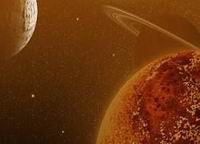Terrestrial bacteria can live on Mars
 Can there be life on Mars, at least in the form of micro-organisms? Scientists have not been able to answer this question clearly. What if they could do the opposite - simulate "Martian" conditions for terrestrial bacteria in a laboratory and see if they survive? Such an experiment was designed by a group of researchers from the University of Padua (Italy).
Can there be life on Mars, at least in the form of micro-organisms? Scientists have not been able to answer this question clearly. What if they could do the opposite - simulate "Martian" conditions for terrestrial bacteria in a laboratory and see if they survive? Such an experiment was designed by a group of researchers from the University of Padua (Italy).
Once, Soviet astronomer Tikhy suggested that Mars is red because of red vegetation on it. However, the scientist was wrong. The probes did not detect any vegetation. The planet looked like a stony desert. The soil, sand and stones have a reddish tint due to an excess of iron oxide. It is present in the blood of living creatures, turning it red. No wonder that in the medieval alchemy Mars was a symbol of iron. Simply put, the entire surface of the planet is covered with rust. This suggests that Mars once had oxygen and water. Otherwise, how could iron get oxidized? The pictures display dry riverbeds and canyons that once represented oceans, seas, rivers and lakes. As for oxygen, it is likely that the same way as on Earth it was produced by plants. Hence, there was some form of life on Mars.
Most scientists are inclined to think that there was a global catastrophe on Mars that destroyed the traces of life on this planet. Experts estimate that this happened over three billion years ago. As a result of a cataclysm the water on Mars evaporated, and the atmosphere became rarefied and unfit for life (at least as we know it).
What are the causes of the death of the planet? The pictures show outlines of volcanoes. One of them, Olympus, is 24 kilometers tall, which is twice the height of Mount Everest. Was it the eruption? Mars is almost four times smaller than Earth, and volcanic activity could cause it severe damage.
Also read: Alien and human skulls found on Mars
As early as in 1976 scientists got hold of samples of Martian soil, extracted by space probe "Viking". The sample was placed in a special incubator in the hope that bacteria that could potentially be present there would somehow manifest themselves.
Despite the fact that no traces of microorganisms have been observed in the samples, debates about the study are ongoing. According to proponents of the existence of extraterrestrial life, Martian bacteria could have died being placed in the unfit environment, for example, during transportation to Earth.
If we assume that life on Mars has the same molecular basis as it has on Earth, it is possible to "reverse" the experiment with terrestrial microorganisms. Of course, delivering them to Mars would be difficult, but one could create a laboratory with the environment similar to that on Mars and see if "native" bacteria survive. Incidentally, it can also indirectly confirm or refute the hypothesis that life could have been brought to Mars from Earth or living spores have gotten to Earth from the space.
In "Mars" model where the bacteria were placed, an appropriate temperature range was maintained (up to minus130 - minus 730 Celsius), for which the "air" was constantly cooled by liquid nitrogen. The atmosphere contained 95 percent carbon dioxide, and corresponding pressure and intensity of UV radiation were also maintained.
Also read: Pyramids discovered on Mars
It turned out that some bacteria species like Bacillus, Deinococcus and Mycobacterium are resistant to extremely low temperatures, low pressure and dry atmosphere. In the absence of water they have adapted to adverse conditions by forming endospores with a thick wall to protect the DNA. However, under ultraviolet absolutely all the organisms died. When the radiation was removed, simulating a "night on Mars," bacterial spores continued to show signs of life, especially if they had access to water. In addition, in the process of imitation of "dust storms" by means of volcanic ash or particles of iron oxide, a dust layer served as a screen against UV radiation, which contributed to the survival of microorganisms.
According to the researchers, the discovery of water on Mars, as well as traces of methane in its atmosphere, hypothetically suggest that there may be some form of life, but it is likely to remain only deep in the bowels of the planet where the effects of radiation and low temperature are minimal and where, perhaps, water in its liquid form still exists.
Irina Shlionskaya
Pravda.Ru
Subscribe to Pravda.Ru Telegram channel, Facebook, RSS!



